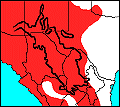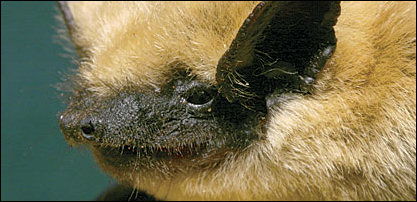


Parastrellus hesperus. U.S. National Park Service photograph, Canyonlands National Park.
Until recently, this flying mammal went under the scientific name of Pipistrellus hesperus. This is known to be the smallest bat in the United States. It has a long interfemoral membrane and tail (Cockrum 1982). The coloration of this species varies from a light yellow or gray hue to reddish-brown on the dorsal side with a consistently white belly underneath. It also sports a black mask across the eyes toward the nose and black wings (Whitaker 1980). The adult male averages a total length of 66 mm, and a female is just larger with a length of 73 mm. Western Pipistrelles weigh in at about 3-6 g (Davis and Schmidly 1994).
These bats are the most diurnal of their kind, beginning their feeding flights very early in the evening and often remaining active into the dawn hours. They are slow flyers and can be distinguished from other bats by their slow, fluttery flight which is mainly used for small foraging routes (Davis and Schmidly 1994). Males tend to spend the colder months at lower elevations and make use of warm evenings for feeding times, while females often move to higher elevations and hibernate (Cockrum 1982).
Occurring mostly in areas of rocky exposures, this bat is very commonly found in rock-walled canyons at or below elevations of 1500 m (Cockrum 1982). Other hideouts for this bat include caves and abandoned buildings (Whitaker 1980).
This species is found throughout the southwestern U.S. from the north-central and Big Bend areas of Texas to western New Mexico, Utah, and north into eastern Oregon and southeastern Washington (Whitaker 1980).
Pipistrellus hesperus forages from about 2-15 m above the ground on small, swarming insects. It consumes around 20% of its body weight at each feeding of caddisflies, stoneflies, moths, beetles, flies, mosquitoes, ants, wasps, and so forth (Davis and Schmidly 1994).
Two is a common number of young born to each litter, and the offspring appear in late June or the early part of July (Cockrum 1982). The female's gestation period often runs about 40 days within maternity colonies formed in favored habitats. Newborns weigh less than 1 g at birth but have fast growth rates and, when August comes around, they can fly and are difficult to distinguish from the adults (Davis and Schmidly 1994).
Cockrum, E. L. 1982. Mammals of the Southwest. University of Arizona Press, Tucson, 176 pp.
Davis, W. B., and Schmidly, D. J. 1994. The Mammals of Texas. Texas Parks and Wildlife Press, Austin, 338 pp.
Whitaker, J. O., Jr. 1980. The Audubon Society Field Guide to North American Mammals. Alfred A. Knopf, Inc., New York, 745 pp.
Todd Spurgeon, November 1997.
Last Update: 10 Jan 2011